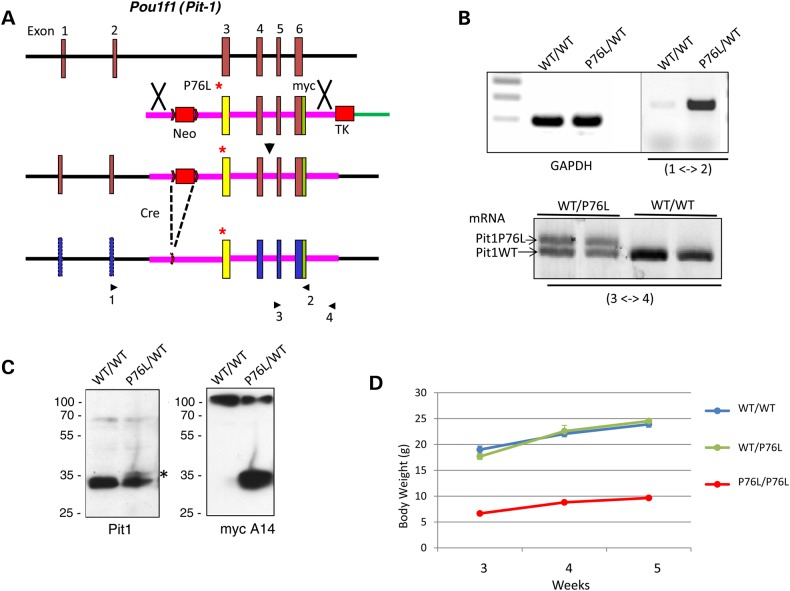Figure 7.
Introduction of the P76L mutation into the Pou1f1 locus in the mouse genome. (A) Homologous recombination at the Pou1f1 locus in the mouse genome. The native-Pou1f1 locus is shown on the top and the targeting vector used to insert the P76L mutation into the locus is shown below. The initial recombination product is displayed on the third line and the final locus after deletion of the NeoR cassette via Cre/Lox recombination is displayed at the bottom. The position of the P76L mutation is denoted by the asterisk, the dual selection cassettes, NeoR and thymidine kinase, are represented by the labeled red rectangles. Lox sites are indicated by the arrowhead and the positions of the primers used for selective detection of the wt and mutant Pou1f1 mRNAs are indicated and numbered below the diagram. (B) mRNA expression from the PitP76L locus in the mouse pituitary. Top: Pou1f1 mRNA expression from the P76L locus was specifically detected in a mouse heterozygous for the mutant allele by an RT/PCR assay using a set of primers positioned at Exon 2 (Primer 1) and within the myc epitope segment in Exon 6 (specific to the mutant allele) (Primer 2). Bottom: the relative levels of the mRNA expression from the wt and the mutant locus were directly compared in a mouse heterozygous for the mutant allele (wt/P76L) and a wt mouse (wt/wt) by an RT/PCR analysis using the Exon 5 primer (Primer 3) and a primer within the 3′ untranslated region (Primer 4) in Exon 4, bracketing the myc epitope tag specific to the mutant locus. (C) Protein expression from the P76L locus in the mouse pituitary. Western blot of pituitary extracts from wt/wt and wt/P76L mice were probed with antibodies to mouse Pou1f1 (left blot) and with an antibody to the myc epitope tag (specific to the mutant locus) (right blot). The overall level of Pou1f1_WT protein in the WT/P76L heterozygote pituitary is approximately half of that in the WT/WT mouse. A faint band at the position of the mutant Pit1 protein (asterisk) is migrating at the position predicted from the Pit-1 protein containing the Myc epitope tag. The expression of the P76L Pou1f1 protein was directly verified by re-probing the western with an antibody to the myc epitope. (D) Growth curves of WT/WT, WT/P76L and P76L/P76L mice. The body weights are shown in the Y-axis and the genotypes are indicted for each curve. The analyses of male mice are shown; a parallel analysis of females gave an identical result (not shown).

